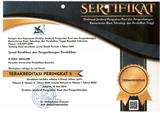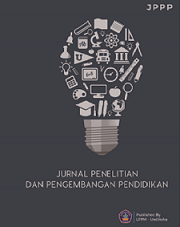Collaborative Project Based Learning Model in English Learning
DOI:
https://doi.org/10.23887/jppp.v7i1.59149Keywords:
Learning Models, News Writing, Problem Based LearningAbstract
In news writing, there are problems with writing skills that are often found in the world of national education. Collaborative, project-based learning models have proven useful for learning English and writing news. Therefore this development research aims to create a project-based learning product model. The Borg & Gall development procedure is followed in this research process. Students and instructors of English study program served as the research subjects. This development method results in reliable, usable, and efficient project-based learning model products for learning to write news stories. In order to collect data for this study, a questionnaire was presented to two material specialists and two media experts. The following are the findings from a study that looked at the viability of developing a project-based learning product learning model for learning how to write news using a Likert scale with a score range of 1 to 5. The results of material experts' validation received a score of 81.54%, placing them in the "very feasible" category. The results of media experts' validation received a score of 78.4%, placing them in the "suitable" category. It is possible to draw the conclusion that the project-based learning model's output is suitable for use in teaching news writing based on the findings of the feasibility study.
References
Alias, N., DeWitt, D., Rahman, M., Gelamdin, R., Rauf, R., & Siraj, S. (2014). Effectiveness of the biology PtechLS module in a Felda Science Centre. Malaysian Online Journal of Edication Technology, 2(4).
Bagon, Š., Gačnik, M., & Starčič, A. I. (2018). Information communication technology use among students in inclusive classrooms. International Journal of Emerging Technologies in Learning, 13(6), 56–72. https://doi.org/10.3991/ijet.v13i06.8051. DOI: https://doi.org/10.3991/ijet.v13i06.8051
Bergström, A., &Belfrage. (2018). News in Social Media. Digital Journalism, 6(5), 1–16. https://doi.org/https://doi.org/10.1080/21670811.2018.1423625. DOI: https://doi.org/10.1080/21670811.2018.1423625
Biria, R., & Jafari, S. (2013). The Impact of Collaborative Writing on the Writing Fluency of Iranian EFL Learners. https://doi.org/10.4304/jltr.4.1.164-175. DOI: https://doi.org/10.4304/jltr.4.1.164-175
Boesman, J., Berbers, A., Haenes, L. d’, & Group, B. Van. (2015). The news is in the frame. A Journalist-Centered Approach to the Frame-Building Process of the Belgian Syrianfighters, 1–19. https://doi.org/https://doi.org/10.1177/1464884915610988. DOI: https://doi.org/10.1177/1464884915610988
Darmawan, D. S., Nuresa, Q. O. A., Khoirunisa, D. N., Widodo, E. R., Wulandari, Y., & Suprapto, E. (2021). Problem Based Learning untuk Meningkatkan Kemampuan Matematika di Sekolah Inklusi. JEMS: Jurnal Edukasi Matematika Dan Sains, 9(2), 236–244. https://doi.org/10.25273/JEMS.V9I2.10343. DOI: https://doi.org/10.25273/jems.v9i2.10343
Darmawati, B., Rahman, M. A., & Halim, A. (2020). The implementation of literature-based instruction in EFL classroom: A case study in an Indonesian junior high school. Asian EFL Journal, 27(2), 211–226. https://doi.org/10.2991/assehr.k.201017.031. DOI: https://doi.org/10.2991/assehr.k.201017.031
Deveci, T. (2018). Student Perceptions on Collaborative Writing in a Project-Based Course. Universal Journal of Educational Research, 6(4), 721–732. https://eric.ed.gov/?id=EJ1175391. DOI: https://doi.org/10.13189/ujer.2018.060415
Gall, M., Gall, J., & Borg, W. (2007). Educational research: an introduction. Pearson/ Allyn & Bacon.
Ghufron, M. A., & Ermawati, S. (2018). The Strengths and Weaknesses of Cooperative Learning and Problem-Based Learning in EFL Writing Class: Teachers’ and Students’ Perspectives. International Journal of Instruction, 11(4), 657–672. http://repository.ikippgribojonegoro.ac.id/id/eprint/461. DOI: https://doi.org/10.12973/iji.2018.11441a
Habibi, F., Eviyuliwati, I., & Kartowisastro, S. (2017). The Effect of Reflective Journal Writing on Students’ Writing Ability of Narrative Text. In International Conference on Education in Muslim Society (ICEMS 2017), 16–20. https://doi.org/10.2991/ICEMS-17.2018.4. DOI: https://doi.org/10.2991/icems-17.2018.4
Husnul, A., & Rohilah. (2019). Improving News Text Writing Skills through Concept Map Media for Class VIII-H Students of SMPN Kota Serang for the 2018/2019 academic year. Journal of Reading Untirta, 3(2), 91–100. https://repository.unair.ac.id/117591/. DOI: https://doi.org/10.30870/jmbsi.v3i2.5222
Ibrahim, N., Shak, M. S. Y., Mohd, T., Ismail, N. A., Perumal, P. D. a/p, Zaidi, A., & Yasin, S. M. A. (2015). The Importance of Implementing Collaborative Learning in the English as a Second Language (ESL) Classroom in Malaysia. Procedia Economics and Finance, C(31), 346–353. https://doi.org/10.1016/S2212-5671(15)01208-3. DOI: https://doi.org/10.1016/S2212-5671(15)01208-3
Javadi-Safa, A. (2018). A Brief Overview of Key Issues in Second Language Writing Teaching and Research. International Journal of Education and Literacy Studies, 6(2), 15–25. https://doi.org/10.7575/aiac.ijels.v.6n.2p.15. DOI: https://doi.org/10.7575/aiac.ijels.v.6n.2p.15
Javed, M., & Juan, W. (2013). A Study of Students’ Assessments in Writing Skills of the English Language. International Journal of Instruction, 6(2), 129–144. https://dergipark.org.tr/en/pub/eiji/issue/5137/70005.
Khairullah, Syambasril, & Wartiningsih, A. (2019). Learning to Write Explanatory Texts for Class XI Students of SMAS Mujahidin Pontianak Academic Year2018/2019. Equatorial Journal of Education and Learning, 8(3), 1–11. https://jurnal.untan.ac.id/index.php/jpdpb/article/view/31625.
Khatimah, H. (2018). Position and Role of Media in Community Life. Tasamuh Journal, 16(1), 119–136. https://doi.org/10.20414/tasamuh.v16i1.548. DOI: https://doi.org/10.20414/tasamuh.v16i1.548
Li, S., & Swanson, P. B. (2014). Engaging language learners through technology integration: Theory, applications, and outcomes. Engaging Language Learners through Technology Integration: Theory, Applications, and Outcomes, 1–368. https://doi.org/10.4018/978-1-4666-6174-5. DOI: https://doi.org/10.4018/978-1-4666-6174-5
Masitoh, S., & Suprijadi, D. (2015). Improving Students Ability in Writing Descriptive Text Using Genre Based Approach (GBA) at the Eighth Grade Students of FitrahInsani Integrated Islamic Middle School. Eltin Journal, 3(1), 38–52. https://doi.org/10.22460/eltin.v3i1.p%25p.
Osman, G., Duffy, T. M., Chang, J. yu, & Lee, J. (2011). Learning through collaboration: Student perspectives. Asia Pacific Education Review, 12(4), 547–558. https://doi.org/10.1007/S12564-011-9156-Y. DOI: https://doi.org/10.1007/s12564-011-9156-y
Resendy, M. (2016). The Attraction of Journalism, Press, News and Different Roles in News Casting. Journal of Al - Hikmah, 4(2), 1–12. http://jurnal.staiba.ac.id/index.php/alhikmah.
Riduwan. (2012). Skala Pengukuran Variabel-Variabel Penelitian. Alfabeta.
Sefriani, R., & Wijaya, I. (2018). Pembuatan Modul Pembelajaran Multimedia Interaktif Berbasis Adobe Dircetor pada Mata Pelajaran Sistem Operasi Sekolah Menengah Kejuruan. INTECOMS: Journal of Information Technology and Computer Science. https://doi.org/10.31539/intecoms.v1i1.124. DOI: https://doi.org/10.31539/intecoms.v1i1.124
Storch, N. (2013). Collaborative Writing in L2 Classrooms. https://doi.org/10.21832/9781847699954. DOI: https://doi.org/10.21832/9781847699954
Swandhana, K., Churiyah, M., & Juariyah, L. (2016). No Tieningkatkan Kemandirian Belajar dan Hasil Belajar Siswa melalui Pengembangan Modul Administrasi Kepegawaian Berbasis Strategi Pembelajaran Inkuiri Terbimbing. JurnalPendidikanBisnis Dan Manajemen, 2(3), 161–169. http://journal2.um.ac.id/index.php/jpbm/article/view/1706.
Taylor, L., & Wigglesworth, G. (2009). Are two heads better than one? Pair work in L2 assessment contexts. Language Testing, 26(3), 325–339. https://doi.org/10.1177/0265532209104665. DOI: https://doi.org/10.1177/0265532209104665
Wardiani, R. &Mulyaningsih, I. (2015). Ability to Write Descriptions (Case Study at Nuurusshiddiiq Islamic Boarding School. 1(1), 1–15. https://doi.org/10.24235/ileal.v1i1.36. DOI: https://doi.org/10.24235/ileal.v1i1.36
Wismath, S. L., & Orr, D. (2015). Collaborative Learning in Problem Solving: A Case Study in Metacognitive Learning. The Canadian Journal for the Scholarship of Teaching and Learning, 6(3). https://doi.org/10.5206/CJSOTL-RCACEA.2015.3.10. DOI: https://doi.org/10.5206/cjsotl-rcacea.2015.3.10
Wulandari, N., Hendratno, H., & Indarti, T. (2020). Development of Pop-Up Book Media based on Balanced Literacy Approach to Improve Skills of Reading Class 1 Students Basic School. International Journal of Multicultural and Multireligious Understanding, 7(5), 619. https://doi.org/10.18415/ijmmu.v7i5.1693. DOI: https://doi.org/10.18415/ijmmu.v7i5.1693
Yavuz, O., & Arslan, A. (2018). Cooperative Learning in Acquisition of the English Language Skills. European Journal of Educational Research, 7(3), 591–600. https://doi.org/10.12973/eu-jer.7.3.591. DOI: https://doi.org/10.12973/eu-jer.7.3.591
Yulastri, A., Hidayat, H., Genefri, Islami, S., & Edya, F. (2017). Developing an entrepreneurship module by using a product-based learning approach in vocational education. International Journal of Environmental & Science Education, 12(5), 1097–1109. https://eric.ed.gov/?id=EJ1085937.
Zeki, & Tanyeli, N. (2016). Impact of Collaborative and Reflective Writing Activities on Students’ Autonomy in Writing: An Action Research on Freshmen Law Students. Qual Quant, 52(1), 343–360. https://doi.org/10.1007/s11135-017-0615-3. DOI: https://doi.org/10.1007/s11135-017-0615-3
Zhou, X., Chen, L.-H., & Chen, C.-L. (2019). Collaborative Learning by Teaching: A Pedagogy between Learner-Centered and Learner-Driven. https://doi.org/10.3390/su11041174 DOI: https://doi.org/10.3390/su11041174
Downloads
Published
How to Cite
Issue
Section
License
Copyright (c) 2023 Aswadi Jaya, Asti Veto Mortini

This work is licensed under a Creative Commons Attribution-ShareAlike 4.0 International License.
Authors who publish with the Jurnal Penelitian dan Pengembangan Pendidikan agree to the following terms:
- Authors retain copyright and grant the journal the right of first publication with the work simultaneously licensed under a Creative Commons Attribution License (CC BY-SA 4.0) that allows others to share the work with an acknowledgment of the work's authorship and initial publication in this journal.
- Authors are able to enter into separate, additional contractual arrangements for the non-exclusive distribution of the journal's published version of the work (e.g., post it to an institutional repository or publish it in a book), with an acknowledgment of its initial publication in this journal.
- Authors are permitted and encouraged to post their work online (e.g., in institutional repositories or on their website) prior to and during the submission process, as it can lead to productive exchanges, as well as earlier and greater citation of published work. (See The Effect of Open Access)







